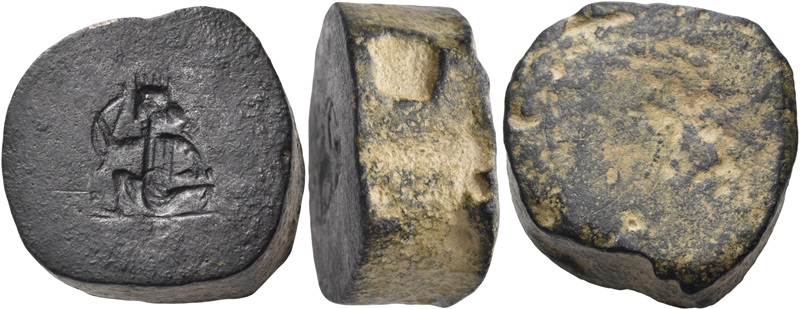Lot 199

PERSIA, Achaemenid Empire. Time of Artaxerxes I to Xerxes II, circa 455-420 BC. Die of a Siglos (Orichalcum, 29X11 mm, 56.49 g), a heavy, hard bronze, roughly circular, thick, 'disc'-like die, designed to be set into an anvil, so it could be used in striking the obverses of silver sigloi., Needless to say, this obverse die would have been accompanied by a punch die, which, during the minting process, would have been held by a moneyer who had positioned the punch over a silver flan that had been placed on the obverse die. Then, a second man,. Persian king, wearing radiate tiara, in the running/kneeling position to left, holding a dagger in his right hand and a bow in his left, and with a quiver over his shoulder; the whole engraved in incuse. For the coin type, see Carradice Type IV A and pl. XIII, 33; and BMC Arabia pl. XXVII, 7. For one of many sigloi with this type of obverse, see CNG e 306, 2013, 195. basically about as made.
The wide margins around the engraved area of this die meant that the coins struck from it would have had perfectly flat fields around the type. What is particularly intriguing about this piece is that it shows no real signs of use; as if it had been made, perhaps to replace an existing die that had become worn, or as a reserve, but had not been used to mint actual coins. Thus, while it could be an official die, it could also be a die made by a contemporary forger; if worse comes to worst, it could even have been made much more recently (cf. Gitler, et.al., A Group of False Roman Coin Dies, SNR 78, 1999, pp. 101-115, especially p. 106, 16). To be sure, to us the die's appearance and corrosion argues for its genuineness, but its unused state has to be noted and explained. In fact, we can explain this apparent anomaly from the condition of a number of archaeologically excavated dies from Egypt, especially those recently found at Herakleion (see: A. Meadows, Athenian coin dies from Egypt: the new discovery at Herakleion, RBN 157, 2011, pp. 97-117). The Herakleion die (a cube of bronze engraved with three obverses for Athenian tetradrachms, aligned so that each was opposite a flat area, thus ensuring that when one die was in use neither of the other two would be damaged. What is important is that this die cube, while indubitably genuine, shows no real signs of use. But whether this was an official die, or one made by a contemporary forger, or counterfeiter - like those from Egypt, is unclear.
Current Status
Online bidding closes: 17 Nov 2019, 10:00:00 CET Current Date & Time: 25 Apr 2024, 11:18:10 CEST Remaining Time: Closed Hammer Price:4000 CHFPre-Bidding closes on 17 November 2019 at 10:00 CET. Live bidding starts at 14:00 CET and is EXCLUSIVELY available on biddr. Separate registration is required.
